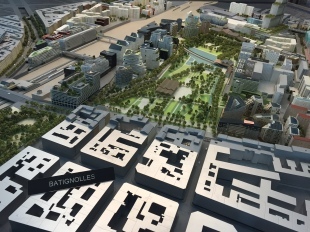PARIS ― As a city where 2 million residents coexist with several million visitors and an average of 28 million commutes are made every day, Paris, like many other metropolitan cities, considers tackling air pollution and emissions as a top priority to solving public health issues.

According to the City of Paris, several millions of residents in the French capital and its surrounding areas were found to have been exposed to particles declared “known carcinogens” by the World Health Organization in June 2012. They were potentially subjected to levels of PM10 particles, PM2 particles and nitrogen dioxide beyond regulatory limits as of 2013.
A study coordinated by the Institute for Public Health Surveillance in 2011 also showed that the air pollution costs residents in the surrounding areas six months of life expectancy and provokes factors that contribute to respiratory problems and heart attacks.
It estimated that the pollution’s impact on health, quality of life and life expectancy would represent a cost of about 31.5 billion euros ($35.6 billion) for European public officials.
“Air pollution is the unacceptable, and yet avoidable, cause of 42,000 deaths per year in France. It reduces our life expectancy by six to nine months,” said Bernard Jomier, the deputy mayor in charge of health measures.
The city found out that road traffic emits 66 percent of nitrogen and 56 percent of PM10 fine particles, making it the main source of air pollutants.
Realizing the urgency to fight against air pollution, the Council of Paris unanimously adopted the Paris Climate Action Plan in 2007 in an aim to cut the overall emissions by 75 percent by 2020 compared to the 2004 level. France was the first country that implemented the climate change plan.
The goal included a 25 percent reduction in greenhouse gas emissions, 25 percent reduction in energy consumption, and energy consumption comprising 25 percent renewable and recovered energy.
In order to achieve the goal, the French capital launched environment initiatives with a particular focus on encouraging green transportation and traffic and parking.
It aggressively pursued an electric car sharing project while expanding public transportation such as subway lines and trams, and motivating residents to give up combustion-powered cars in return for financial incentives.
Autolib, the public electric car sharing service, has served as one of the convenient transportation means for Parisians since 2011.
Through the service, Parisians can take and park the electric cars anywhere in the city for only around 10 euros per month.
Autolib is a follow-up to the successful bike sharing service Velib, which was launched in 2007. Velib has attracted over 286,000 annual subscriptions, which is equivalent to 1 in 8 Parisians.
Currently, about 3,300 Autolib cars are running in the city, with nearly 1,000 charging stations in operation. To raise service availability, the city offers over 5,500 parking lots across the city.
About 10 million have registered for the service since 2011, with 90,000 customers actively utilizing it. The service is also available in 64 other municipalities.
While some express concerns over the performance of the electric cars, Blue Solution of Bollore Group, which is in charge of producing the electronic components for capacitors, stressed that the special battery not only allows car users to ride longer but also safer.
The lithium metal polymer battery is safer than liquid electrolyte batteries because of better temperature stability, it said. It also enables the cars to run up to 250 kilometers per charge. It can also be recycled as the battery does not contain any toxin components, company officials said.
Regardless of such innovative development of the electric cars, the Autolib service had a rough start due to public discontent over occupying the public space.
“Parisians were not pleased with the service at first because the Autolib parking lots took up large spaces in the crowded city. The beginning was only possible thanks to the amazing harmony of political courage and entrepreneur will,” Blue Solution sales manager Serge Amabile told The Korea Herald.
Despite such public concerns, the former city government aggressively pushed for the project with a 3 billion euro private investment. It is expected to break even by next year, Amabile added.
The company is currently pushing to expand its Bluebus electric bus service, with a few already running in the capital and other municipalities.
In addition to encouraging green transportation, Paris is committed to building an exemplary eco-district in the city to seek the urban sustainability since 2002. With an aim to reach zero energy use, the city has transformed a small neighborhood of Clichy-Batignolles in northwestern Paris into the greenest neighborhood in France.
As of now, the 50-hectare region on the outskirts of Paris is currently home to 6,500 residents along with a 10-hectare park and over-140,000-square-meter modern offices with eco-friendly features.
The region was nothing more than a railroad company-owned site used for technical facilities and maintenance jobs until a public firm purchased the land for the urban sustainability project.
The project was initially pushed as part of the government’s efforts to host the 2012 Olympic Games. Although France failed to host the world’s largest sporting event, Paris continued to promote the eco-region project.
In the region, only 12 percent of the area is allocated for roads in order to limit traffic and concentrate flow along a few major roads. The city also made efforts to slow down vehicles and discourage transit traffic by designating 30-kilometer-per-hour speed zones and building winding roads.
Under the rule, buildings in the region must meet particularly stringent energy-consumption limitations. All must be equipped with a geothermal-powered urban heating system. The circulated heat is reused for waste burning.
The buildings must also have solar panels on the roof. As of now, a combined 40,000 square meters of solar panels are installed in the district, supplying 50 percent of the total energy consumption, city officials said.
The active use of the sun’s natural heat and light was possible because the buildings were initially built with effective insulation and glazing, natural ventilation and heat recuperation, the city said.
The city also pursues a unique waste collection system. Instead of running waste collection trucks, it introduced a pneumatic underground waste collection system, which sorts the waste before it is sent to waste terminals.
The waste is then sucked through underground pipes to the compacting terminal, where just four trucks per week suffice to take the waste away.
Building the green district would have been impossible without the public consensus, city officials said.
“While it could have affected their daily life during the construction, Parisians around the neighborhood were optimistic of turning the region into an eco-district as they could expect the benefits of the new district,” said eco-district official Nicolas Rouge, who is in charge of managing the sustainable development.
With Paris actively putting efforts into carrying out various climate change measures, it has already seen changes in their environment.
According to a study conducted by French environment group Airparif conducted between 2002 and 2012, the decade-long efforts to reduce road traffic and encourage green transportation methods led to an unprecedented fall in pollution.
The study showed that PM10 emissions fell by 35 percent, nitrogen oxide by 30 percent and greenhouse gases by 13 percent. This was equivalent to exposing 1.7 million fewer residents to fine particles each year.
In December, Paris is to host the United Nations Climate Change Conference or COP 21, where countries are likely to declare a new landmark agreement on post-2020 emissions cut targets. The COP 21 is aimed at limiting global warming to 2 degrees Celsius, which experts consider as the threshold for climate change.
By Lee Hyun-jeong, Korea Herald correspondent (rene@heraldcorp.com)



![[Herald Interview] 'Amid aging population, Korea to invite more young professionals from overseas'](http://res.heraldm.com/phpwas/restmb_idxmake.php?idx=644&simg=/content/image/2024/04/24/20240424050844_0.jpg&u=20240424200058)














